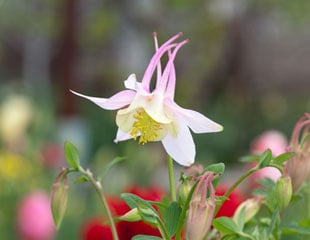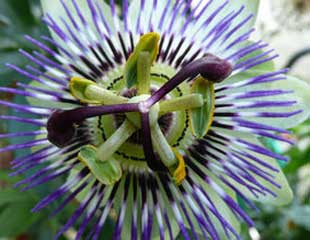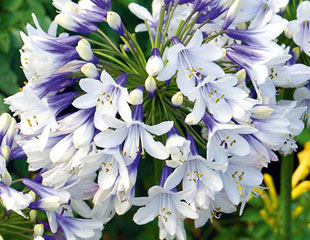


Plants for Seaside Gardens
There is a great range of plants which grow well in seaside gardens. The milder conditions allow the seaside gardener to grow plants which would not thrive in some more exposed areas of the UK.
Many of these plants do not require much maintenance, which can be important if the house and garden are not occupied all year round. Plants need to be self sufficient.
Below are ideas, images and growing tips for Seaside Gardens.
For more ideas, check out gardening by the Seaside and Shrubs for Seaside gardens
I love Thalictrum, tall with floating fluffy flowers which drift on the breeze. Thalictrum is easy to grow, a herbaceous perennial which comes back year after year. It will self seed and, although tall, not all varieties require staking.

Eryngiums, common name Sea Holly as its name suggests, are happy in a coastal garden. Eryngiums need a little protection in the winter, which is often milder in coastal gardens. They are much loved by bees.
Alchemilla mollis common name Lady's mantle, tough, self sufficient, and a self seeder. It requires no real attention, a herbaceous perennial which returns reliably each year. Alchemilla is very easy to grow, perhaps too easy. Dead head it if you want to stop it self seeding.
The passion flower looks exotic but is easy to grow and thrives in coastal gardens. Illustrated is Passiflora caerulea which can be semi/evergreen in more sheltered conditions and is a lovely climbing plant for a sheltered wall - growing tips.
Everyone loves Agapanthus with their large striking flower heads in shades of blue and white. Agapanthus can be temperamental but is a breeze to grow in milder coastal gardens- they grow almost wild in Cornwall and Scilly Isles see how to grow Agapanthus.
Crocosmia grows from corms planting in the autumn and has flowers which are bright red, yellow and orange depending on the variety. Illustrated is the tall and very scarlet C. Lucifer. Crocosmia is easy to grow and maintenance free. In ideal growing conditions, it can be a bit invasive, but easily checked.
Aubretia, a simple plant, easy to grow plant which is often overlooked, adds early colour flowering from March onwards and looks just fabulous tumbling over a wall. Video on how to cut back Aubretia and tips about growing Aubretia
Achillea illustrated here and top left has feathery green/grey foliage and large flat flower heads made up of many tiny flowers. It looks good with some many garden plants and grasses. Achillea is easy to grow and trouble free. Check out the smell of the foliage first, it's not to everyone's taste.
Erysimum, the common wallflower, has one of the most irresistible, sweetest scents of any garden plant. A short-lived perennial which flowers for a long time in spring, they look great with Tulips and spring bedding.
Aquilegia is a delicate spring flowering herbaceous perennial. It is not fussy about growing conditions and will self seed around the garden. The only maintenance, which is optional, is to cut back the tired old foliage after flowering.
The Himalayan Blue Poppy, or Meconopsis grandis, proves challenging to establish and is (very) picky about its growing conditions. However, it compensates with the most breathtaking blue flowers. Specifically, it thrives in cool and damp conditions, making it suitable for gardens in the northern regions. Detailed guidance for cultivation.
Sedums are mainly herbaceous perennials, which return reliably each year. There are a lot of sedums to choose from and they are very attractive to pollinators, bees and butterflies.
I like to plant them near a patio where I can sit back and enjoy the wildlife. Sedums are a magnet for bees and butterflies. Don't take my word for it check out this short video.
Hemerocallis, common name Day lily, is a herbaceous perennial with large flowers. Although the flowers are short-lived, around a day, this clump forming plant flowers profusely over a long period. There is a huge range of flower colours to choose from, including attractively striped varieties. It is a grow anywhere plant and suitable for coastal gardens.

This is a bold grass, which is a strong grower, needs a fair amount of space, but makes are real splash with the brightly striped variegated leaves. Miscanthus sinensis has large plumes in the summer up to a metre high.
Several grasses are suitable for coastal gardens and would look good planted with Achillea, Thalictrum and Agapanthus.

Bees love chives, which make a lovely edging plant. In a good summer, they will flower several times if regularly cut back, providing food for us and the bees. This video shows the bees making a bee line for the chives.

I cannot resist dahlia in all their different shapes and colours. In mild coastal areas, it is possible to leave them in the ground over winter. Tips for growing Dahlia plus Crocus have a fabulous selection.
More ideas about plants and shrubs suitable for seaside gardens Gardening by the seaside and Shrubs for Seaside gardens
To buy shrubs for seaside gardens, Crocus has many of the plants listed and more (affiliate link)












